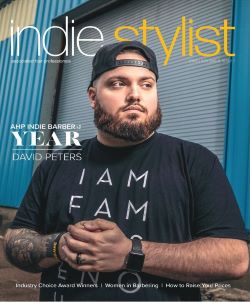Conquering adversity and overcoming fear are nothing new to Lici “Lady Barber” Febo. She has been doing just that—on her own—since she was 16. So, it should come as no surprise that she also shattered one of the most historically difficult glass ceilings to smash: the barbershop, where men and boys gather, sometimes weekly, to swap stories, express vulnerabilities, provide support, and build community. Even today, a trip to the barbershop isn’t just for the haircut; it’s more about community and culture. The same community and culture that historically shunned women as customers, let alone accepted them as barbers.
Today, Febo is a top female barber with over 90,000 Instagram followers (@lici_ladybarber), but she didn’t enter the barbering vocation looking to smash gender barriers. Quite the opposite. If you ask Febo, she’ll tell you that barbering found her, not the other way around. “I picked up a pair of clippers at a very young age,” she remembers. “My father was always very attentive to his hair and his appearance, and I would always pay attention to his hair care routine.” But though he loved to look good, Lici says her dad also loved to party. “My household growing up was difficult,” she shares. “My father was an alcoholic . . . and that always meant trouble for my siblings and me.”
At 5 years old, Febo suffered third-degree burns on her right arm and leg, and the fingers of her right hand were fused together. After 6 years, numerous surgeries, and countless therapy sessions, Febo taught herself to write and draw with her left hand and says she “dove into” crafting to build dexterity in her fingers. She was also homeschooled because of her surgeries, so her bedroom became her sanctuary. “Outside my bedroom door was chaos,” she says, “so I found a distraction in watching music videos. I was truly inspired by the different looks of the artists and tried replicating the hairstyles and pretending I was the artist. Janet Jackson was one of my favorites. My parents never took us out to be groomed, so I took the initiative to practice on my brother and sister. Then my cousins, aunts, and so on.”
When Febo was 16 years old, her mother died, and her father was incarcerated. “It wasn’t long before the bank foreclosed on the house,” she said. “My brother was sent to the military, my younger sister to a foster home, and since I was too old, I was left in the street. That’s when I began to cut hair to survive.”
Being on her own was trying for Febo. “I made so many wrong choices growing up as I played this game of life,” she says, “but the one thing that kept me sane was cutting hair. I charged $5 a haircut— humble beginnings. I eventually went to school for it after one of my clients encouraged me to. At the time, I didn’t even know you could make a career out of cutting hair!”
Article by Lisa Bakewell
This article appears in Volume 3 Issue 1 of AHP Indie Stylist magazine
AHP Indie Stylist is AHP's bimonthly publication, created to speak directly to you, the independent hair stylist and barber.
In this issue:
• Industry Choice Awards: The votes are in and the industry has spoken
• AHP Indie Barber of the Year: Pittsburgh Dave is the owner of Steel City Barber Lounge
• How to Raise Your Prices: Why, when, and how to raise your services prices

